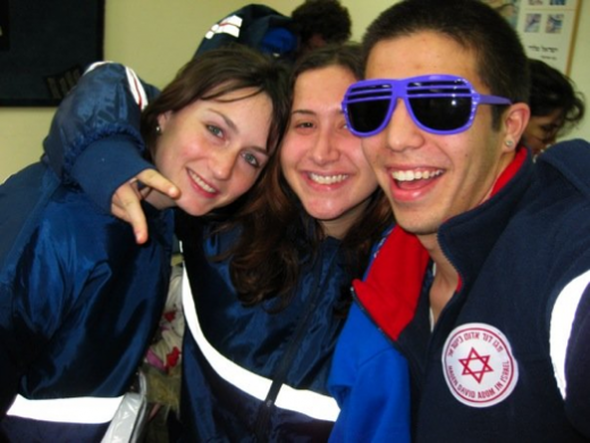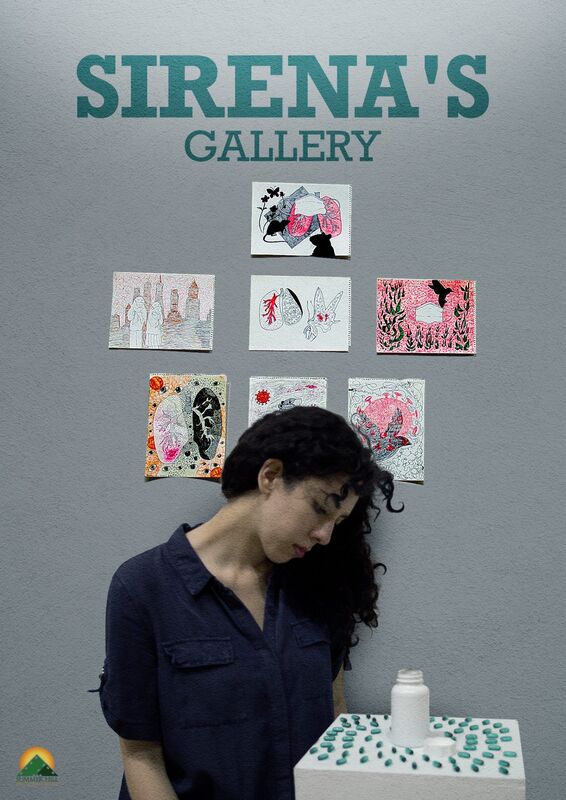|
The Breadcrumbs widget will appear here on the published site.
Days and Nights in South Ashkelon Editor's Note: This piece first appeared on Woman Around Town. Pictured: Sarah Sullivan, Ali Somer, and Daniel Gavens. In the hazy early-morning light, we could barely see our patient. He lay fifteen feet down in a construction pit of loose rocks, broken and moaning with his leg twisted unnaturally under him. Our ambulance team—Moti the senior paramedic, Gavy the senior EMT, and Danel and I the junior EMTs—glanced at each other anxiously. The injured man below us was barely conscious and gasping for air—a result of hemopneumothorax, a trauma injury where blood and air rushes into the pleural space and collapses the lung. This should have been a call for theNatan, the Mobile ICU, and not the regular ambulance patrolling fractured hips and diabetic syncope. Danel and I rushed to the ambulance for the backboard while Moti and Gavy climbed a rickety ladder down into the pit. A few minutes later Moti surfaced, his dark hair slicked with sweat. “That guy’s in bad shape,” he said gravely. “We need to get him out of there stat, but he’s too heavy to lift up the ladder on the backboard.” A soft groan came from the pit. “Call the bulldozer over!” Moti directed. Danel and I passed the backboard and supplies down the ladder while the bulldozer slowly lowered its jaws five, ten, twelve feet down into the pit. Gavy and Moti hurriedly strapped our patient to the backboard and on the count of three lifted him into the jaws of the bulldozer. Gavy climbed in next to our patient and yelled, “Raise us up!” Back in the rattling ambulance, with Moti speeding fifty miles an hour over curbs and through intersections, Danel bandaged the man’s bleeding face while I splinted the broken leg. We rushed through the doors of the emergency room at full tilt. Two doctors immediately began emergency surgery on the patient’s lungs so he could breathe again. Sweating and disheveled, we filled out the paperwork and slid the stretcher back in the ambulance with a sigh of relief. “Well,” Gavy said after a while. “You don’t see that every day.” This is the life of an emergency medical technician. You have the critical rescues thrown in with the jumble of routine calls and false alarms. But in our case it was compounded by rocket fire from the Gaza border six miles away, adding another factor to an already complicated equation. I was a junior EMT in South Ashkelon in early 2009, right after Israel’s 2008 Operation Cast Lead ground invasion of Gaza, and the rockets never stopped coming. Ashkelon was no stranger to violence. Waves of conquerors, from the Canaanites to the Philistines to the Mamluks, swept through its stone walls for millennia. By 2009, north Ashkelon was a pristine seaside resort with joggers and gourmet cafes. The southern part, poorer and wilder, housed Israel’s influx of immigrants from Ethiopia and Eastern Europe. I lived in a housing complex for recent arrivals called a merkaz klita, or absorption center, in a neighborhood so indigent that it lacked restaurants and nightclubs. On weekend nights, my neighbors sat on their sidewalks listening to tinny pop music on their cellphones. The streets lay quiet under the sun-baked heat; no one could afford a car. Every morning a shepherd passed through with several goats. Into this destitute area the militants of Hamas aimed their rockets. There were Qassams, the smaller homemade ones, and then the big Russian-made artillery, the Grads and Katyushas. Every morning as I walked to the station, I traced my fingers against the pockmarked side of a concrete wall where a Qassam had exploded, and thanked my lucky stars. The past year, a Grad missile had taken out the local mall. While the Iron Dome intercepted most of the rockets, south Ashkelon’s proximity to Gaza meant that it bore the brunt of any fire aimed directly north of the Gaza line. This was confusing to our neighbors, most of whom had emigrated from Uzbekistan or Russia with only a dim idea of the current situation. Israel had recently absorbed 2,000 refugees from south Sudan, some of whom ended up in Ashkelon and were perplexed as to why they were being fired upon. Watching a Russian construction worker drag slabs of cement from the ruined mall, I thought, This rocket was made in your country. And now it’s being used against you. The geopolitical complexity was bizarre. Tzeva adom. The rocket alarm sounded when my best friend Ali was in the shower. Red Alert. It was a calm female voice, almost nonchalant, reminding us that we had fifteen seconds to scramble into the nearest bomb shelter. Soapy and shrieking, Ali and I dove into the stairwell and huddled together beneath the creaky metal stairs. I dimly wondered if this would be my last minute on earth. It wasn’t. The rocket hit a field somewhere. This was our life, the existence of every citizen of Ashkelon. No matter where you were—work, school, even the shower—the threat always lurked fifteen seconds away. And there was an even bigger threat: distraction, disruption. It was difficult enough to start out as an EMT, let alone with the constant reminder of rocket fire. I only worked as an EMT in south Ashkelon for a few months before my student visa expired. Luckily, I never saw any casualties from the rockets. But what really struck me were the perplexed and harried looks of my neighbors, who had escaped grinding poverty in Africa and Russia for a life running from rocket fire. One of our calls was an elderly Russian man, softly coughing up blood from an advanced case of tuberculosis. He would be safer in the hospital, his petite wife assured us, because he was too frail to run to the bomb shelter. And then she spread her hands: “Why us?” #Real #PeaceInTheMiddleEast #Israel #Gaza #Palestine #Memoir #FirstPerson #Essay #CreativeNonfiction #ItHappenedToMe Visit our shop and subscribe. Sponsor us. Submit and become a contributor. Like us on Facebook and follow us on Twitter. CommentsComments are closed.
|
|









